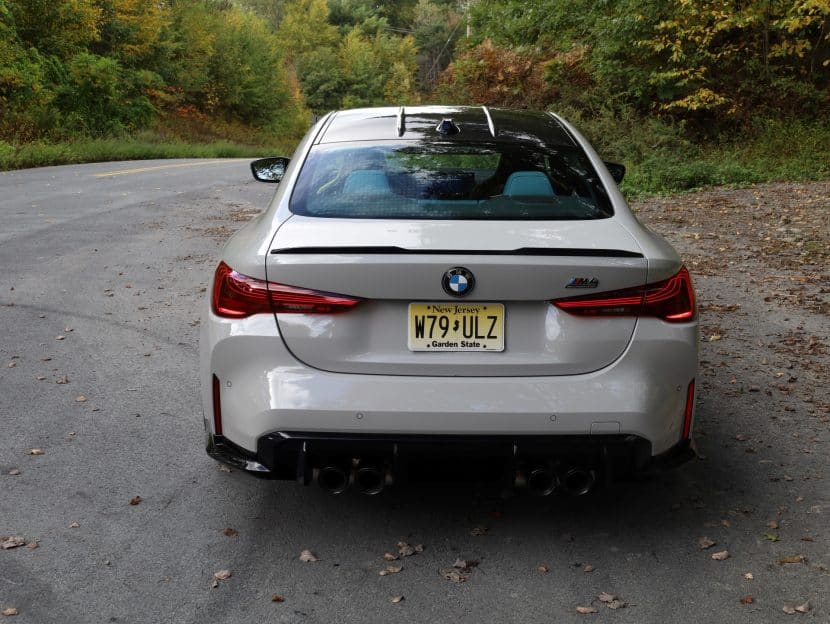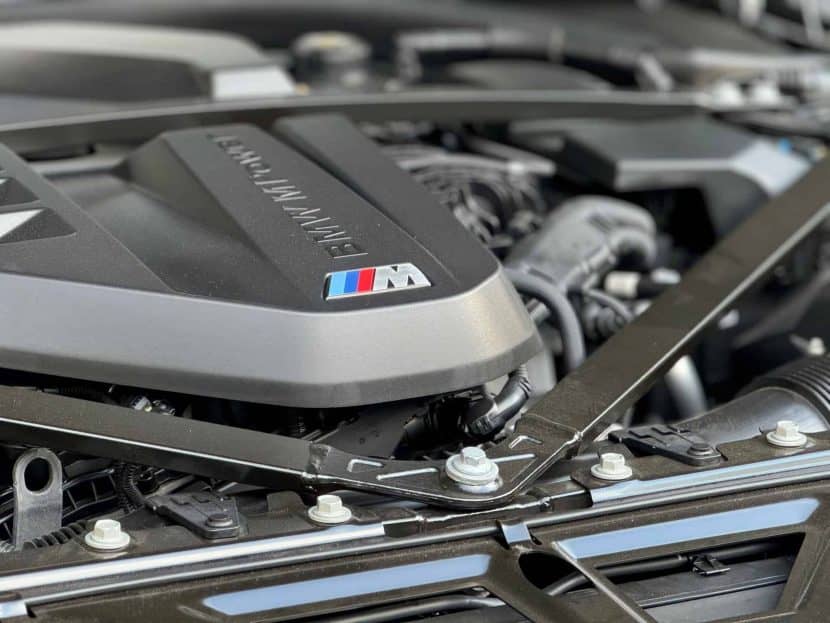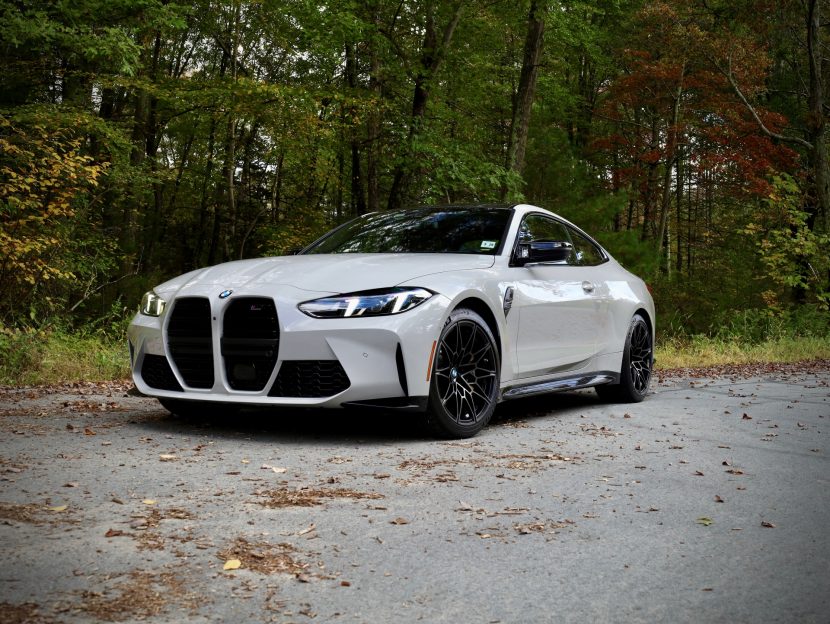You won’t believe it if you spend too much time on the Internet, but most things in life exist in a gray area. That’s one way to say that rather than being entirely good or entirely bad, most events, people, and objects sit somewhere in between. Appropriate, then, that our loaner 2025 BMW M4 Competition showed up wearing $4,500 gray paint. Actually, it’s called Chalk, and like the minimal improvements that the 2025 BMW M4 gets for its mid-life-cycle refresh, it does little to help the car’s polarizing aesthetics.
We spent a week with this 2025 BMW M4 Competition that showed up wearing gold-painted carbon ceramic brakes and a refreshingly unique Yas Marina Blue, yellow, and black interior. There’s no doubt this car came dressed to impress. But does it hold up after a week of scrutiny?
Subtle Design Tweaks: What’s New for 2025?

Unfortunately, early rumors of the beaver-tooth grille’s death have been greatly exaggerated. The 2025 BMW M4 gets only mild changes for the new model year, and most non-enthusiasts will have trouble spotting any differences at all. Get granular and you’ll notice new headlights, LED taillights with laser elements lifted right off the M4 CS and M4 CSL models, and slightly tweaked badging. Inside, a squared-off steering wheel and new center vents mirror what you find almost everywhere else in the current BMW lineup.
Perhaps most importantly, the LCI M4 (2025+) gets iDrive 8.5, which adds QuickSelect and generally makes things easier to live with on the tech side. The changes are welcome but will probably only impress true nerds.
2025 BMW M4 Competition
Good
- Feels more communicative and engaging than its pre-facelift predecessor
- iDrive 8.5 infotainment system is faster,
- Carbon ceramic brakes provide excellent stopping power
Bad
- Polarizing Design
- Stiff Ride Quality
- High Price Tag
The Power and Precision of the S58 Engine

Our test car is a 2025 BMW M4 Competition. So, 503 horsepower, 479 pound-feet of torque, and rear-wheel drive with an eight-speed automatic transmission. Power is effortless, and the chassis has more capability than most drivers will know what to do with, especially on the street. Dial down the traction control and the car is cooperative but potentially more eager than its pilot to commit to oversteer. The extra power in the xDrive models – 523 instead of 503 in RWD variants – is probably nice, but I’m not sure you’d really notice any difference. The rear-driven version leaves nothing to be desired when it comes to acceleration.
Prior to this I’ve driven a manual and auto pre-LCI G80 M3, and to be perfectly blunt, this car felt pretty much identical to the last auto G80 I drove in terms of overall performance. Like those cars, this one also felt a little stiffer than it needed to be. Some of the East coast’s roads were downright punishing, even with all the settings in their least-sporting modes.
Handling and Chassis Feedback: A Return to Form?

My biggest takeaways from a week with the G82 M4 were two early and lasting impressions that subverted my expectations. For one, the 2025 BMW M4 was overall a lot more communicative than I remember the G8X chassis being. When behind the wheel, I always had a very clear understanding of what was going on with the car as I drove.
I could feel imperfections in the pavement through the front wheels. I could feel the rear wheels and chassis reacting – predictably – as I squeezed the throttle mid-turn-in. The brake feel – potentially courtesy of our test car’s expensive and optional carbon ceramic discs – was progressive, talkative, and completely fadeless. I’m not calling the driving experience “analog,” but I’ll admit – the whole thing felt a lot more “M-ish” than I remember. Doubly surprising when you consider the enormous screen staring back at me.
iDrive 8.5: A Welcome Tech Upgrade

Speaking of the enormous screen, that was the second positive takeaway from my time with the M4. When I drive, it’s generally to get away from something I use way too much in all other aspects of my life – a screen. The biggest reason I can’t justify buying a new vehicle is the omnipresent glow of an in-dash television. So, I was pleasantly surprised by how little I really needed to interact with it. There was an initial setup period that consisted of maybe ten minutes; tune Apple CarPlay, finalize driving mode options and my M1/M2 button presets, and get the head-up display configured to its least-obstructive setting (low on the windscreen, and not bright).
Past that first get-to-know-you phase, I interacted with the screen on a limited basis. When I did, iDrive 8.5 was responsive and intuitive – quicker than I remember 8 being. It also outperformed my phone in finding nearby coffee spots several times – though that might be more of a reflection on Verizon than the vehicle.
Other Assorted High Points

The advantage of spending a week with a car is that you really get to experience the car as an owner would. First, the BMW M4 surprised me and passengers with its usability. “Are you kidding? There’s so much space back here!” That’s an actual quote from a friend who is fairly certain his Audi A3 sedan has less space in the backseat than my M4 demo did. We’ll take it. The carbon bucket seats are extremely comfortable once you’re situated in them – although that can, admittedly, take some doing. The car remained composed even through brief periods of chilly rain, despite the car wearing Michelin Pilot Sport 4S summer tires.
Perfect is the Enemy of Good

The M4 does a lot of things right. But it isn’t perfect. I still think the design leaves a lot to be desired. To the car’s credit, everyone else I introduced to it loved it – car-savvy or otherwise. They thought it looked aggressive and “like a race car.” My design complaints extend to the interior, where I wish BMW gave us the option for a slightly less digital gauge cluster. The car is also pricy; our mule carried a price tag of $108,945, an objectively large sum of cash. Perhaps a larger problem is that the car’s limits are so high that it sometimes struggles to feel engaging if you aren’t traveling at high speeds. Both latter issues can at least partially be remedied by opting for a manual transmission, but we’ve digressed.
Should I Buy One?

Viewed through a lens with any sort of pragmatism attached to it, the BMW M4 is quite good. Competitors like the CT4-V Blackwing and Alfa Romeo Giulia Quadrifoglio offer similar thrills with much lower-rent interior bits. The newest C63 – arguably the M3/M4 duo’s historic rival – relies on a hybrid powertrain that most consider to be positively tragic. It also weighs considerably more than it should and around 900 pounds more than the M4.
In my eyes, the 2025 BMW M4 Competition is a logical progression from its predecessor. Comparing spec sheets, you’ll be hard-pressed to find something it doesn’t do better. And we have a lot to be thankful for. There’s no whacky hybrid tech, you still have a gem of an engine under the hood, and the interior feels like a special place to be.
So, despite widespread whinging about BMW M losing the plot, I submit that this car continues to adhere to the M3 ethos 40 years on. It’s a tremendously capable streetcar and practical daily driver that is happy to spend some time on the track if you’re so inclined. But bring your checkbook.
2025 BMW M4 Competition
Exterior Appeal
Interior Quality
Steering Feedback
Performance
Handling
BMWness/Ultimate Driving Machine
Price Point
Ultimately, the 2025 BMW M4 Competition might be a logical evolution rather than a revolutionary leap, but it’s a refinement of an already excellent platform. It stands out against competitors like the CT4-V Blackwing and Giulia Quadrifoglio with its robust powertrain and well-rounded nature. It also dodges the pitfalls of hybridized powertrains like the latest C63 AMG, preserving the visceral experience purists crave. For buyers who want a capable, daily-drivable M car that’s as comfortable on the track as it is on a spirited backroad, the 2025 M4 Competition checks all the boxes—if they’re willing to pay the price.















































































